Corporate Governance for Banks in Southeast Europe: Policy - IFC
Corporate Governance for Banks in Southeast Europe: Policy - IFC
Corporate Governance for Banks in Southeast Europe: Policy - IFC
Create successful ePaper yourself
Turn your PDF publications into a flip-book with our unique Google optimized e-Paper software.
B. Risk management and <strong>in</strong>ternal controls 43,44B1. Risk management versus <strong>in</strong>ternal control 45Risk management and <strong>in</strong>ternal control are twoprocesses that work hand <strong>in</strong> hand. Risk managementis <strong>in</strong>tended to 1) identify risks; 2) assess the bank’sexposure to risks; 3) monitor exposure and conductconsequential capital plann<strong>in</strong>g; 4) monitor and assessdecision mak<strong>in</strong>g as it relates to risk, <strong>in</strong> particular,whether risk decisions are <strong>in</strong> l<strong>in</strong>e with board-approvedrisk tolerance and policy; and 5) report to seniormanagement and the board.Internal control, on the other hand, ensures thateach key risk has an associated policy and controlmechanism, and that each control policy andmechanism is be<strong>in</strong>g applied effectively. Internal controlsprovide a variety of assurances to management, suchas the reliability of <strong>in</strong><strong>for</strong>mation, compliance with law,compliance with governance systems, prevention ofexcessive managerial discretion or fraud, and so on. It isa key responsibility of the board to ensure that effectivesystems of risk management and control are <strong>in</strong> place. 46Risk Management and RiskManagement Culture“When sophisticated risk management comestoo late, I do not th<strong>in</strong>k there is much reasonto celebrate.”George Bobvos, Montenegro“Effective risk management is not aboutelim<strong>in</strong>at<strong>in</strong>g risk-tak<strong>in</strong>g; risk-tak<strong>in</strong>g is afundamental driv<strong>in</strong>g <strong>for</strong>ce <strong>in</strong> bus<strong>in</strong>ess andentrepreneurship. The aim should be to ensurethat risks are understood and managed and,when appropriate, communicated.”Hans Christiansen, Denmark“One of the most important lessons that I th<strong>in</strong>kcomes out of the crisis from a governancepo<strong>in</strong>t of view is a focus on the risk governancerole of a board.”A best-practice board will typically need to rely onan <strong>in</strong>ternal auditor to provide the board, via theCather<strong>in</strong>e Lawton, United K<strong>in</strong>gdomaudit committee, with assurances regard<strong>in</strong>g thebank’s risk management and <strong>in</strong>ternal controls andcorporate governance processes. The <strong>in</strong>ternal auditor traditionally reports to management adm<strong>in</strong>istrativelyand to the board functionally, with the head of <strong>in</strong>ternal audit report<strong>in</strong>g directly to the chairperson of theaudit committee or to an <strong>in</strong>dependent lead board member. Internal auditors should enjoy substantive<strong>in</strong>dependence from management and have direct access to the board.Supervisors and bankers may use the term <strong>in</strong>ternal control to refer to a variety of aspects of the controlenvironment, <strong>in</strong>clud<strong>in</strong>g risk management, <strong>in</strong>ternal audit, controls, and compliance. Irrespective of how thefunctions of the control environment are named, each one is necessary and should be per<strong>for</strong>med effectively.In addition, a bank’s general counsel or legal function contributes significantly to the control of risk. Manyproblems <strong>in</strong> developed markets dur<strong>in</strong>g the recent f<strong>in</strong>ancial crisis resulted from legal risk failures.For banks <strong>in</strong> the SEE region, implement<strong>in</strong>g effective and reliable risk management and <strong>in</strong>ternal controls is oneof the most important challenges. It is only through an effective control environment that the board can beconfident that the <strong>in</strong><strong>for</strong>mation and reports that it receives are reliable. It is also the only way the board canexpress itself with any certa<strong>in</strong>ty on the risks <strong>in</strong> the bank.43 2010 BIS Pr<strong>in</strong>ciples, Section III.C, p. 17.44 For additional specific guidance on risk management, see CEBS, High Level Pr<strong>in</strong>ciples <strong>for</strong> Risk Management (2010).http://www.eba.europa.eu/documents/Publications/Standards---Guidel<strong>in</strong>es/2010/Risk-management/HighLevelpr<strong>in</strong>ciplesonriskmanagement.aspx.45 2010 BIS Pr<strong>in</strong>ciples, Section III.C, p. 17.46 See also BIS, Framework <strong>for</strong> Internal Control Systems <strong>in</strong> Bank<strong>in</strong>g Organizations (1998).34<strong>Policy</strong> Brief<strong>Corporate</strong> <strong>Governance</strong> <strong>for</strong> <strong>Banks</strong> <strong>in</strong> <strong>Southeast</strong> <strong>Europe</strong>


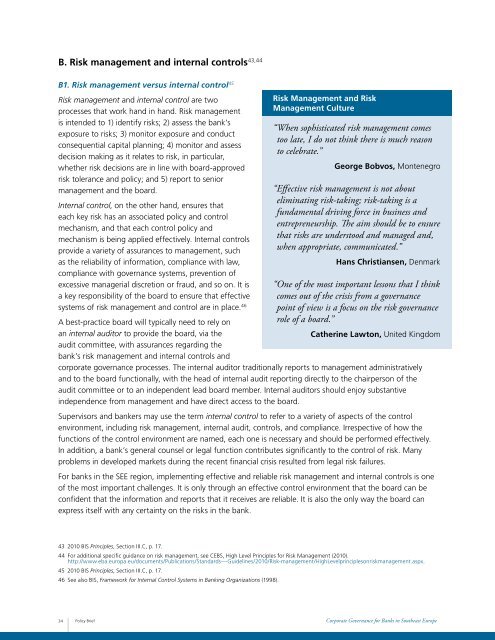
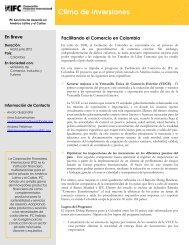
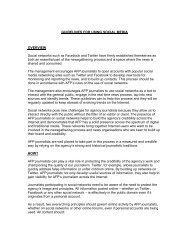
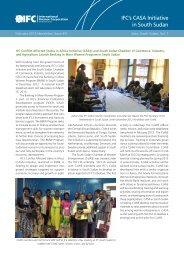

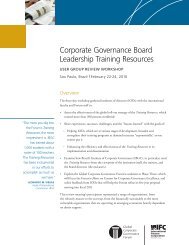




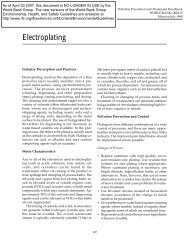
![Print a two-page fact sheet on this project [PDF] - IFC](https://img.yumpu.com/43449799/1/190x245/print-a-two-page-fact-sheet-on-this-project-pdf-ifc.jpg?quality=85)


